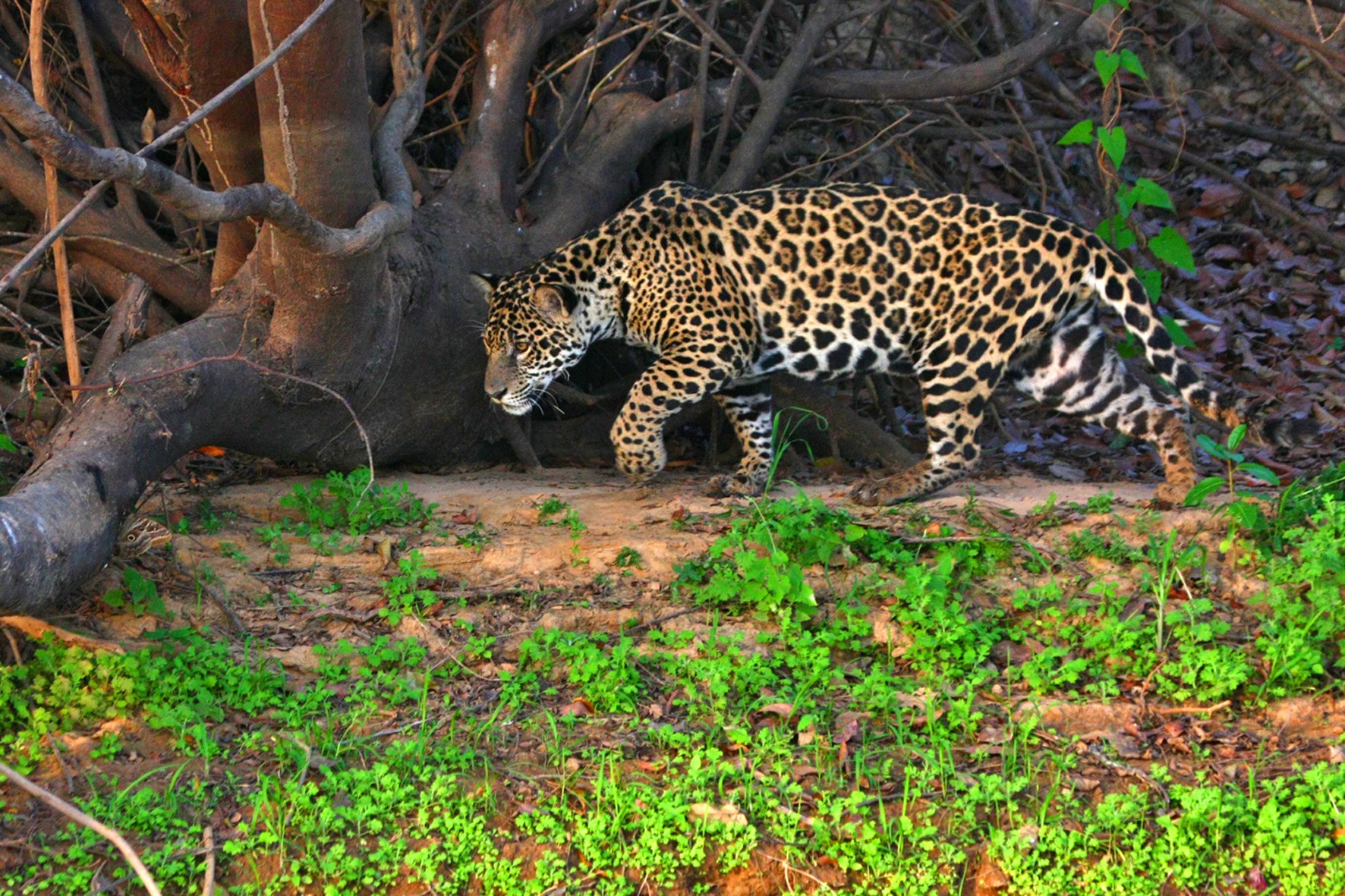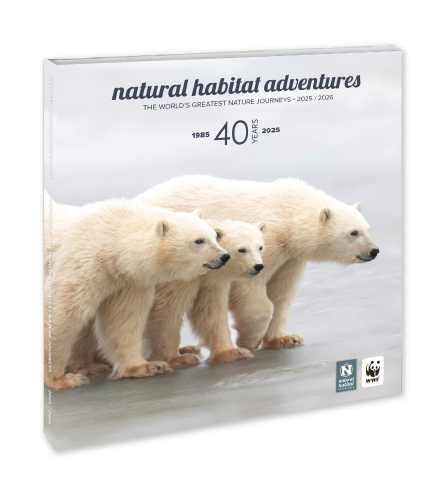Aerial view of the Pantanal in Brazil. © Juan Pratginestos/WWF-Canon
The Pantanal is the largest wetland in South America and the largest wetland in the world that has not been substantially modified by humans. The sheer abundance of large birds, reptiles and mammals mark its importance as a huge reservoir of biodiversity. Here are 11 facts about these wondrous wetlands:
Pantanal Fact #1 The Pantanal covers an area of 66,100 square miles—that’s 10 times the size of Florida’s Everglades.
Pantanal Fact #2 Sediment cores suggest that 13,000-23,000 years ago, the Pantanal was covered by sandy desert.
Pantanal Fact #3 The name “Pantanal” comes from the Portuguese word pântano , meaning wetland, bog, swamp or marsh.
The name “Pantanal” comes from the Portuguese word pântano , meaning wetland, bog, swamp or marsh. © Edward Parker/WWF-Canon
Pantanal Fact #4 Average yearly rainfall in the Pantanal reaches up to 40 to 55 inches. Seventy-eight percent of the Pantanal is submerged during the rainy seasons.
Pantanal Fact #5 The Pantanal is home to about 3,500 plant species, 656 bird species, 325 fish species, 159 mammals, 53 amphibians and 98 reptiles.
The Pantanal is home to about 656 bird species. © R. Isotti, A. Cambone/Homo Ambiens/WWF-Canon
Pantanal Fact #6 The Pantanal Conservation area—a group of four protected areas in the Pantanal—was declared a UNESCO World Heritage Site due to its ecological significance.
Pantanal Fact #7 While the Pantanal is considered one of the most preserved wetlands in the world, less than 2 percent of the Pantanal wetlands is under government protection.
Pantanal Fact #8 The Pantanal is threatened by expanding human settlement, unsustainable farming practices, illegal mining, hydroelectric power plant construction and unregulated tourism. WWF is working with ranchers in Brazil to reduce deforestation and its negative impacts.
Less than 2 percent of the Pantanal wetlands is under government protection. © ZAPA/Natural Habitat Adventures
Pantanal Fact #9 A 2012 report from WWF-UK found that the Pantanal wetlands attract nearly 1 million tourists every year, making ecotourism more profitable to community members than the use of land for livestock and crops.
Pantanal Fact #10 WWF partners with the Nature Conservancy, UNESCO and IBAMA—a Brazilian environmental agency—to conserve Natural World Heritage Sites in the Pantanal.
Request Your 2025/2026 Catalog
Discover the World's Best
Nature Travel Experiences
Together, Natural Habitat Adventures and World Wildlife Fund have teamed up to arrange nearly 100 nature travel experiences around the planet, while helping to protect the magnificent places we visit and their wild inhabitants.
Discover the World's Best
Nature Travel Experiences
Our weekly eNewsletter highlights new adventures, exclusive offers, webinars, nature news, travel ideas, photography tips and more. Sign up today!
Hidden form View
Home Trips Trips Catalog Catalog Contact Contact More More Have a question or comment? Hours Mountain Time
×
Home
Trips
Trips
Catalog
Catalog
Book
Contact
Contact
More
More
[ebook-modal-wrapper]
[ebook-modal-wrapper]
[full-width-start]
[full-width-start]
[full-width-end]
[full-width-end]
[aside-height-start]
[aside-height-start]
[aside-height-end form-start]
[aside-height-end form-start]
[aside-content-start aside-text-start]
[aside-content-start aside-text-start]
[aside-text-end]
[aside-text-end]
[aside-image-start]
[aside-image-start]
[aside-image-end aside-content-end]
[aside-image-end aside-content-end]
[content-start subheader-start]
[content-start subheader-start]
[subheader-end main-header-start]
[subheader-end main-header-start]
[main-header-end image-height-start]
[main-header-end image-height-start]
[image-height-end content-end]
[image-height-end content-end]
[ebook-header-optin]
[ebook-header-optin]
[ebook-subheader-optin]
[ebook-subheader-optin]
[ebook-aside-image]
[ebook-aside-image]
[ebook-aside-text]
[ebook-aside-text]
[ebook-logos]
[ebook-logos]
[form-header-start]
[form-header-start]
[form-header-end form-start]
[form-header-end form-start]
[ebook-header-form]
[ebook-header-form]
[privacy-policy]
[privacy-policy]
[ebook-form-sms-text-wrapper]
[ebook-form-sms-text-wrapper]
[ebook-sms-privacy-wrapper]
[ebook-sms-privacy-wrapper]
[ebook-sms-fine-print]
[ebook-sms-fine-print]
[ebook-submit-button]
[ebook-submit-button]
[ebook-header-success]
[ebook-header-success]
[ebook-success-text]
[ebook-success-text]
[thank-you-start]
[thank-you-start]
[thank-you-end link-text-start]
[thank-you-end link-text-start]
[link-text-end]
[link-text-end]
[aside-start]
[aside-start]
[aside-end form-start]
[aside-end form-start]
[content-start]
[content-start]
[content-end]
[content-end]
[aside-content-start aside-image-start]
[aside-content-start aside-image-start]
[aside-image-end]
[aside-image-end]
[aside-text-start logos-start]
[aside-text-start logos-start]
[aside-text-end logos-end aside-content-end]
[aside-text-end logos-end aside-content-end]
[subheader-start]
[subheader-start]
[main-header-end aside-image-start aside-text-start]
[main-header-end aside-image-start aside-text-start]
[aside-text-end logos-start]
[aside-text-end logos-start]
[aside-image-end logos-end]
[aside-image-end logos-end]
[ebook-modal-wrapper]
[ebook-modal-wrapper]
[full-width-start]
[full-width-start]
[full-width-end]
[full-width-end]
[aside-height-start]
[aside-height-start]
[aside-height-end form-start]
[aside-height-end form-start]
[aside-content-start aside-text-start]
[aside-content-start aside-text-start]
[aside-text-end]
[aside-text-end]
[aside-image-start]
[aside-image-start]
[aside-image-end aside-content-end]
[aside-image-end aside-content-end]
[content-start subheader-start]
[content-start subheader-start]
[subheader-end main-header-start]
[subheader-end main-header-start]
[main-header-end image-height-start]
[main-header-end image-height-start]
[image-height-end content-end]
[image-height-end content-end]
[ebook-header-optin]
[ebook-header-optin]
[ebook-subheader-optin]
[ebook-subheader-optin]
[ebook-aside-image]
[ebook-aside-image]
[ebook-aside-text]
[ebook-aside-text]
[ebook-logos]
[ebook-logos]
[form-header-start]
[form-header-start]
[form-header-end form-start]
[form-header-end form-start]
[ebook-header-form]
[ebook-header-form]
[privacy-policy]
[privacy-policy]
[ebook-form-sms-text-wrapper]
[ebook-form-sms-text-wrapper]
[ebook-sms-privacy-wrapper]
[ebook-sms-privacy-wrapper]
[ebook-sms-fine-print]
[ebook-sms-fine-print]
[ebook-submit-button]
[ebook-submit-button]
[ebook-header-success]
[ebook-header-success]
[ebook-success-text]
[ebook-success-text]
[thank-you-start]
[thank-you-start]
[thank-you-end link-text-start]
[thank-you-end link-text-start]
[link-text-end]
[link-text-end]
[aside-start]
[aside-start]
[aside-end form-start]
[aside-end form-start]
[content-start]
[content-start]
[content-end]
[content-end]
[aside-content-start aside-image-start]
[aside-content-start aside-image-start]
[aside-image-end]
[aside-image-end]
[aside-text-start logos-start]
[aside-text-start logos-start]
[aside-text-end logos-end aside-content-end]
[aside-text-end logos-end aside-content-end]
[subheader-start]
[subheader-start]
[main-header-end aside-image-start aside-text-start]
[main-header-end aside-image-start aside-text-start]
[aside-text-end logos-start]
[aside-text-end logos-start]
[aside-image-end logos-end]
[aside-image-end logos-end]
[ebook-modal-wrapper]
[ebook-modal-wrapper]
[ebook-background-image]
[ebook-background-image]
[ebook-header-optin]
[ebook-header-optin]
[ebook-subheader-optin]
[ebook-subheader-optin]
[privacy-policy]
[privacy-policy]
[ebook-form-sms-text-wrapper]
[ebook-form-sms-text-wrapper]
[ebook-sms-privacy-wrapper]
[ebook-sms-privacy-wrapper]
[ebook-sms-fine-print]
[ebook-sms-fine-print]
[ebook-submit-button]
[ebook-submit-button]
[ebook-header-success]
[ebook-header-success]
[ebook-success-text]
[ebook-success-text]
[full-width-start]
[full-width-start]
[full-width-end]
[full-width-end]
[image-height-start]
[image-height-start]
[image-height-end content-start]
[image-height-end content-start]
[content-end]
[content-end]
[content-start subheader-start]
[content-start subheader-start]
[subheader-end main-header-start]
[subheader-end main-header-start]
[main-header-end form-start]
[main-header-end form-start]
[form-end content-end]
[form-end content-end]
[full-width-start logos-start]
[full-width-start logos-start]
[image-height-start logos-start]
[image-height-start logos-start]
[logos-start]
[logos-start]
[logos-end content-start]
[logos-end content-start]
[full-height-start]
[full-height-start]
[logos-start content-start]
[logos-start content-start]
[logos-end content-end full-height-end]
[logos-end content-end full-height-end]
[main-header-start]
[main-header-start]
[main-header-end subheader-start]
[main-header-end subheader-start]
[subheader-end form-start]
[subheader-end form-start]
[thank-you-start]
[thank-you-start]
[thank-you-end link-text-start]
[thank-you-end link-text-start]
[link-text-end]
[link-text-end]
[ebook-modal-wrapper]
[ebook-modal-wrapper]
[ebook-background-image]
[ebook-background-image]
[ebook-header-optin]
[ebook-header-optin]
[ebook-subheader-optin]
[ebook-subheader-optin]
[privacy-policy]
[privacy-policy]
[ebook-form-sms-text-wrapper]
[ebook-form-sms-text-wrapper]
[ebook-sms-privacy-wrapper]
[ebook-sms-privacy-wrapper]
[ebook-sms-fine-print]
[ebook-sms-fine-print]
[ebook-submit-button]
[ebook-submit-button]
[ebook-header-success]
[ebook-header-success]
[ebook-success-text]
[ebook-success-text]
[full-width-start]
[full-width-start]
[full-width-end]
[full-width-end]
[image-height-start]
[image-height-start]
[image-height-end content-start]
[image-height-end content-start]
[content-end]
[content-end]
[content-start subheader-start]
[content-start subheader-start]
[subheader-end main-header-start]
[subheader-end main-header-start]
[main-header-end form-start]
[main-header-end form-start]
[form-end content-end]
[form-end content-end]
[full-width-start logos-start]
[full-width-start logos-start]
[image-height-start logos-start]
[image-height-start logos-start]
[logos-start]
[logos-start]
[logos-end content-start]
[logos-end content-start]
[full-height-start]
[full-height-start]
[logos-start content-start]
[logos-start content-start]
[logos-end content-end full-height-end]
[logos-end content-end full-height-end]
[main-header-start]
[main-header-start]
[main-header-end subheader-start]
[main-header-end subheader-start]
[subheader-end form-start]
[subheader-end form-start]
[thank-you-start]
[thank-you-start]
[thank-you-end link-text-start]
[thank-you-end link-text-start]
[link-text-end]
[link-text-end]
[ebook-modal-wrapper]
[ebook-modal-wrapper]
[ebook-background-image]
[ebook-background-image]
[ebook-header-optin]
[ebook-header-optin]
[ebook-subheader-optin]
[ebook-subheader-optin]
[privacy-policy]
[privacy-policy]
[ebook-form-sms-text-wrapper]
[ebook-form-sms-text-wrapper]
[ebook-sms-privacy-wrapper]
[ebook-sms-privacy-wrapper]
[ebook-sms-fine-print]
[ebook-sms-fine-print]
[ebook-submit-button]
[ebook-submit-button]
[content-start main-header-start]
[content-start main-header-start]
[main-header-end subheader-start]
[main-header-end subheader-start]
[subheader-end content-end]
[subheader-end content-end]
[ebook-header-success]
[ebook-header-success]
[ebook-success-text]
[ebook-success-text]
[full-width-start]
[full-width-start]
[full-width-end]
[full-width-end]
[image-height-start]
[image-height-start]
[image-height-end content-start]
[image-height-end content-start]
[content-end]
[content-end]
[content-start subheader-start]
[content-start subheader-start]
[subheader-end main-header-start]
[subheader-end main-header-start]
[main-header-end form-start]
[main-header-end form-start]
[form-end content-end]
[form-end content-end]
[full-width-start logos-start]
[full-width-start logos-start]
[image-height-start logos-start]
[image-height-start logos-start]
[logos-start]
[logos-start]
[logos-end content-start]
[logos-end content-start]
[full-height-start]
[full-height-start]
[logos-start content-start]
[logos-start content-start]
[logos-end content-end full-height-end]
[logos-end content-end full-height-end]
[main-header-start]
[main-header-start]
[subheader-end form-start]
[subheader-end form-start]
[thank-you-start]
[thank-you-start]
[thank-you-end link-text-start]
[thank-you-end link-text-start]
[link-text-end]
[link-text-end]
[ebook-modal-wrapper]
[ebook-modal-wrapper]
[ebook-background-image]
[ebook-background-image]
[ebook-header-optin]
[ebook-header-optin]
[ebook-subheader-optin]
[ebook-subheader-optin]
[privacy-policy]
[privacy-policy]
[ebook-form-sms-text-wrapper]
[ebook-form-sms-text-wrapper]
[ebook-sms-privacy-wrapper]
[ebook-sms-privacy-wrapper]
[ebook-sms-fine-print]
[ebook-sms-fine-print]
[ebook-submit-button]
[ebook-submit-button]
[ebook-header-success]
[ebook-header-success]
[ebook-success-text]
[ebook-success-text]
[full-width-start]
[full-width-start]
[full-width-end]
[full-width-end]
[image-height-start]
[image-height-start]
[image-height-end content-start]
[image-height-end content-start]
[content-end]
[content-end]
[content-start subheader-start]
[content-start subheader-start]
[subheader-end main-header-start]
[subheader-end main-header-start]
[main-header-end form-start]
[main-header-end form-start]
[form-end content-end]
[form-end content-end]
[full-width-start logos-start]
[full-width-start logos-start]
[image-height-start logos-start]
[image-height-start logos-start]
[logos-start]
[logos-start]
[logos-end content-start]
[logos-end content-start]
[full-height-start]
[full-height-start]
[logos-start content-start]
[logos-start content-start]
[logos-end content-end full-height-end]
[logos-end content-end full-height-end]
[main-header-start]
[main-header-start]
[main-header-end subheader-start]
[main-header-end subheader-start]
[subheader-end form-start]
[subheader-end form-start]
[thank-you-start]
[thank-you-start]
[thank-you-end link-text-start]
[thank-you-end link-text-start]
[link-text-end]
[link-text-end]































I hope we Kenyans can learn a thing and conserve the Mau water towers, the actual source of the Nile water…over 15000 years of conservation has kept Pantanal intact…any threats to Pantanals’ survival should be countered head-on!
This is an amazing web! Really helped with my report!
Hi
The website said 11 facts but there were only 10 facts?
You are right! We just changed the title to 10. Thanks for catching that!